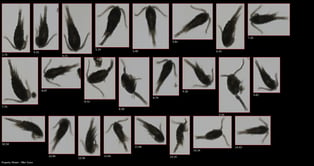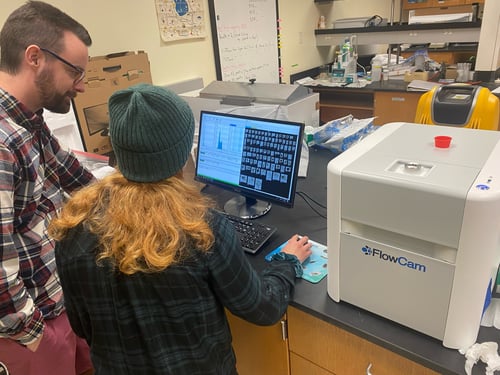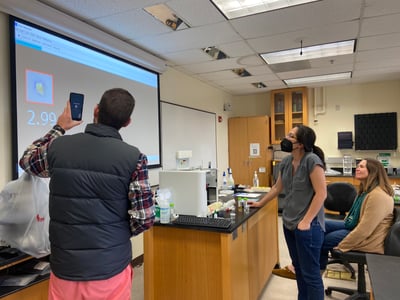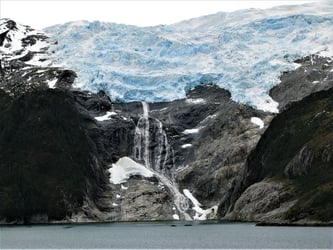"Versatility, ease of use, and student engagement" are among the chief reasons undergraduate programs choose FlowCam.
Our team works with undergraduate faculty nationwide using FlowCam to increase student engagement and research capacity through automated imaging and flow imaging microscopy specifically. FlowCam is well-suited for multi-disciplinary use in an undergraduate STEM program. Many undergraduate faculty want to add particle imaging to their repertoire to quickly provide particle size, shape, and distribution data while teaching students important research methods. The versatility of this technique, its wide particle size range, and its ability to image cells and aquatic organisms add value to the lab. However, demonstrating this value and obtaining funding amidst competing intra- and interdepartmental interests can be challenging.
To help those facing this challenge, we spoke with a team of FlowCam users from the Department of Environmental & Ocean Studies at the University of San Diego (USD), a primarily undergraduate institution. Anthony Basilio, a laboratory technician in the department shared his insights on the educational benefits FlowCam brings to undergraduate programs and offered recommendations for those considering a similar approach.

Q: USD began exploring FlowCam to replace an aging particle counter. What technical and/or pedagogical advantages does FlowCam offer that a traditional particle counter does not?
The FlowCam is more user-friendly, and it’s a bonus that it doesn’t require super-delicate probes or restocking specific solutions. FlowCam also supports a greater variety of applications. It allows us to image phytoplankton, larvae, and other particles in the water, whereas the Coulter Counter was only used for counting cells—a much more limited scope of use. FlowCam is considerably more versatile.
FlowCam's image recognition tools can isolate and enumerate images of copepods, as in the preserved sample from USD. These images were captured on a FlowCam 8100 using a 4X objective and a 300 µm flow cell.
Q: What is the unique value FlowCam offers primarily undergraduate institutions?
The immediacy and ease of sample processing with FlowCam can be extremely valuable in undergraduate institutions. We try to incorporate active data collection into our lab experiences and involve the students as much as possible. Going from sample collection in the field to popping samples into the instrument and seeing live data—all possible during a three-hour lab session—is huge for undergraduate engagement. On the back end, having the ability to play around with creating our sample libraries will help make sampling templates for future semesters.
Q: Why did the team ultimately choose FlowCam?
Our initial goal was to have a single instrument for imaging samples of various sizes, volumes, and magnifications. FlowCam easily met that criteria. We also wanted something that students could learn and become comfortable using independently. Lastly, we experienced great customer service throughout the buying process, making FlowCam an easy choice.
Q: How did USD first learn about FlowCam?
We came to know about FlowCam from several different sources. Some of our faculty members attended an Ocean Sciences Meeting in 2020 and discussed possible applications with members of the FlowCam team. We also started considering applications for one of our upper-division courses. About a year later, Dr. Beth O’Shea was discussing potential algal projects in the Salton Sea with a collaborator outside the university who had mentioned the FlowCam as a potential instrument for that type of research.
Around the same time, Dr. Sue Lowery in Biology expressed how well-suited FlowCam is for our multidisciplinary “Biological Oceanography” class because of its versatility and numerous potential applications. Beth and Sue notified Dr. Jennifer Prairie, our resident authority, about algae. Dr. Prairie forwarded the information to me, the Laboratory Technician/Professor, as a potential purchase, and since so many of the faculty were already interested, it was easy to get the ball rolling! When multiple faculty from different departments can benefit from a single instrument it makes building a case much easier.
Q: Are there unique challenges to purchasing an instrument like FlowCam that you had to overcome?
Our procedure for approving and allocating funds can be a little complicated, as many checks are in place to determine which instruments are ideal for purchase. There are many conversations about department (and college) needs, the hunt for potential instruments to fill those needs (gathering quotes, planning demos, etc.), and requests for fund allocation that may be denied or delayed.
Q: How was your experience during the pre-sale process?
 The process was smooth and efficient! Savannah was incredibly friendly and quick to respond to any questions or concerns. She reached out to interested faculty and helped plan our in-house demo with an appreciated level of coordination. She was also happy to send revised quotes as things changed, keeping the ball rolling for our eventual purchase!
The process was smooth and efficient! Savannah was incredibly friendly and quick to respond to any questions or concerns. She reached out to interested faculty and helped plan our in-house demo with an appreciated level of coordination. She was also happy to send revised quotes as things changed, keeping the ball rolling for our eventual purchase!
Q: How has your experience regarding training been so far?
The training also went very smoothly. Mike was very knowledgeable and ready to answer any of our questions. He quickly got us hands-on with the instrument, ensuring we understood each process step before proceeding. It never felt rushed or too clinical. He’s a very down-to-earth guy who was great to chat with!
Q: How do you think students will react to FlowCam? What impact do you hope it will have on their experience in your department?
We anticipate that they will be excited to use this instrument. They will learn cutting-edge techniques for imaging and counting plankton and gain new skills that can help make them more marketable.
___________________________________________________________________________________________________________________
Thank you so much, Anthony, for sharing your experience! FlowCam’s versatility in handling a wide particle size range, ease of use, and accessibility for students made it the right choice for an undergraduate program like USD’s Departments of Environmental & Ocean Sciences and Biology.
Are you curious to learn more about FlowCam for undergraduate research and teaching?
One year after their FlowCam implementation, we circled back to see how it's going.











